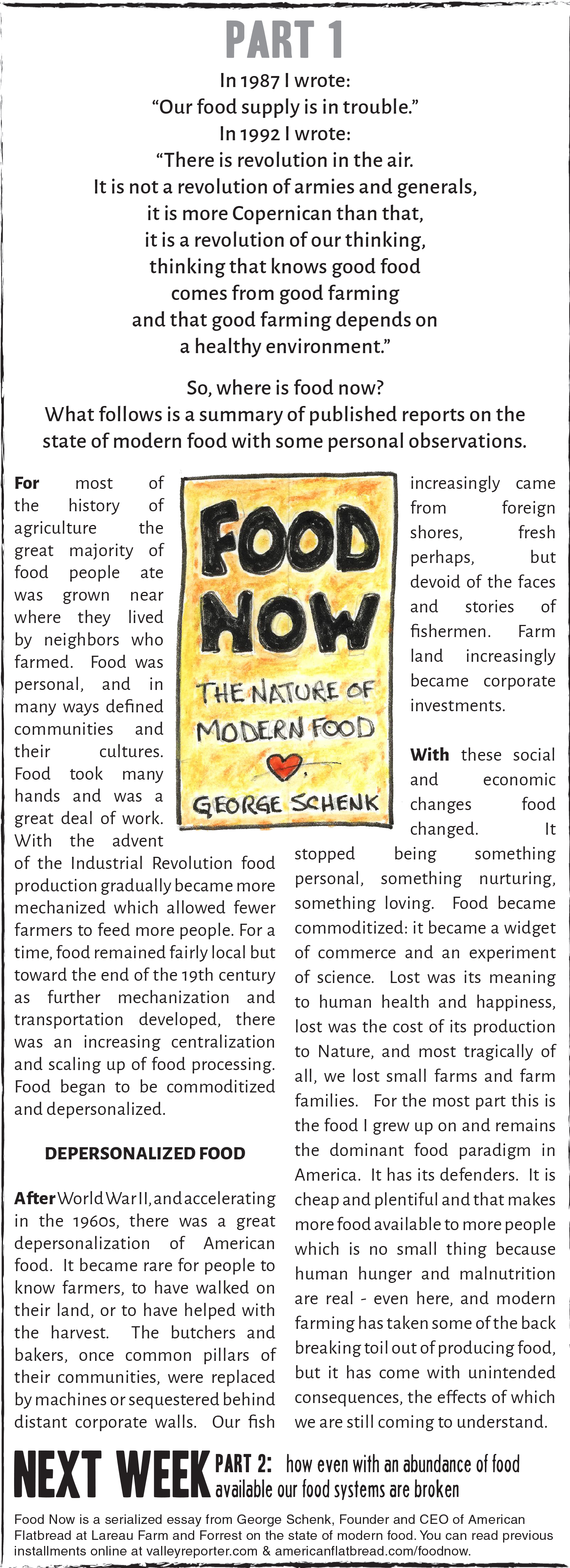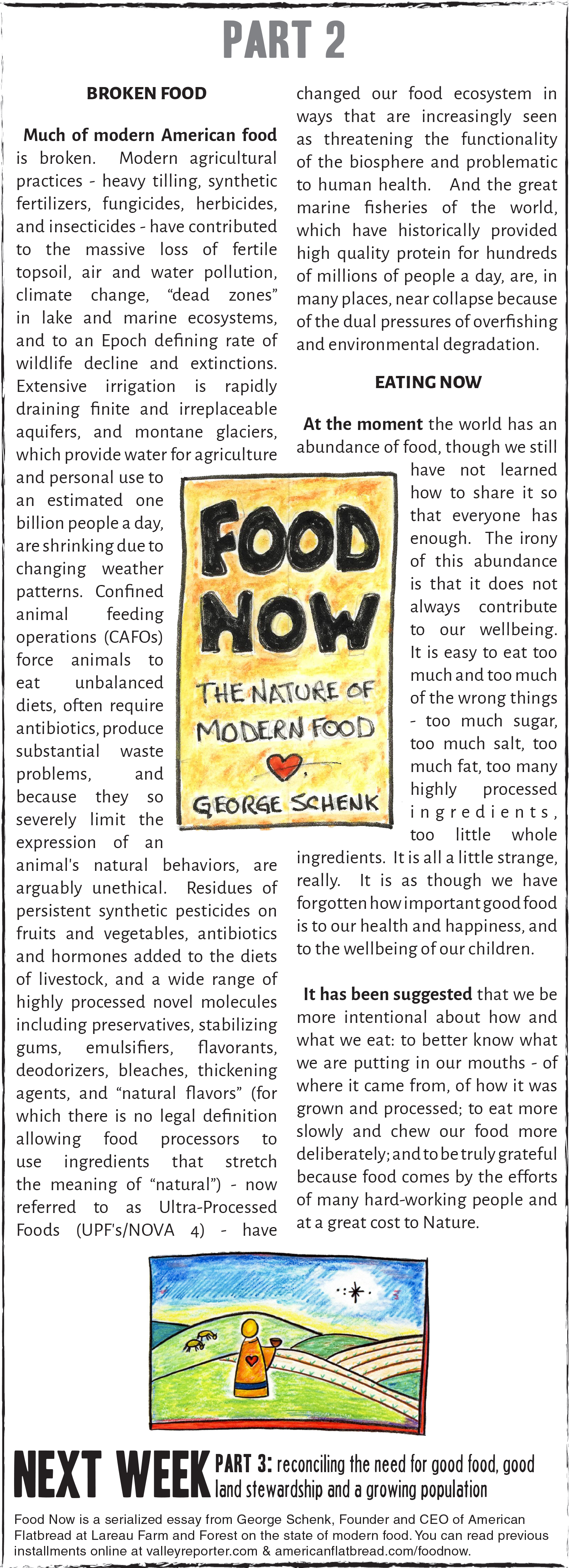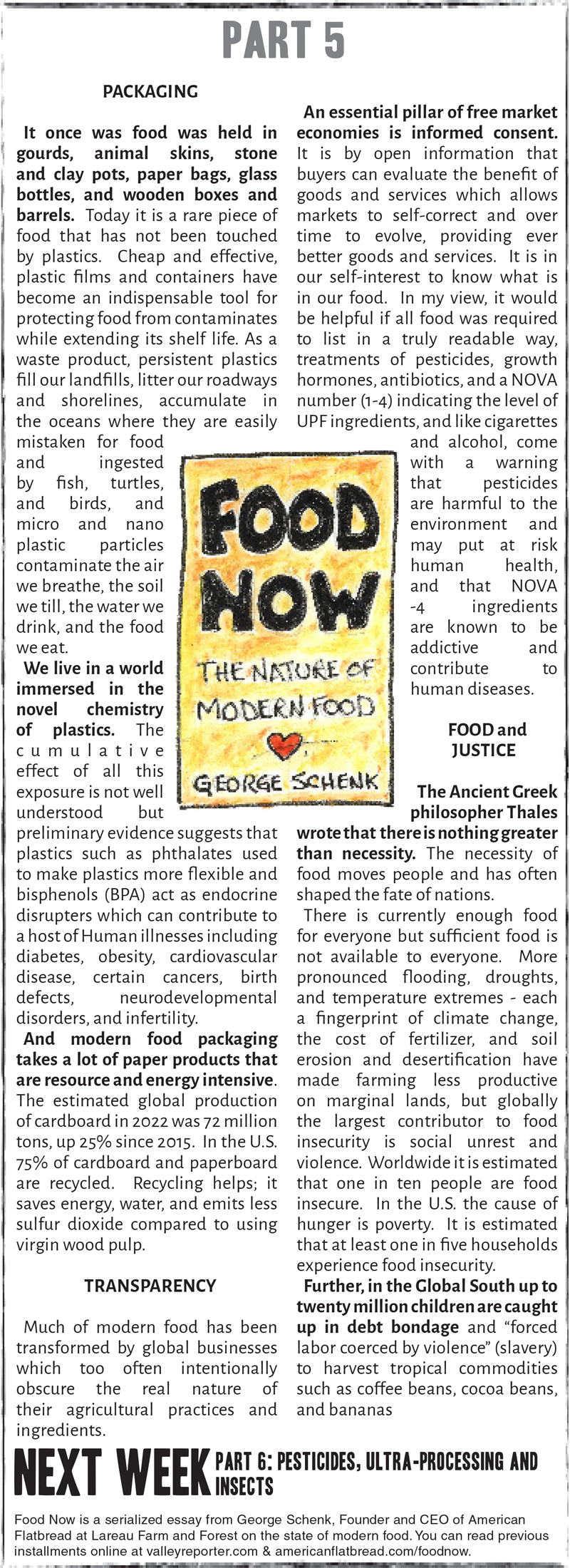PART 1
Click the image above to read Food Now as it appeared in the paper, or scroll down to read the full copy below.
FOOD NOW
In 1987 I wrote:
“Our food supply is in trouble.”
In 1992 I wrote:
“There is revolution in the air.
It is not a revolution of armies and generals,
it is more Copernican than that,
it is a revolution of our thinking,
thinking that knows good food
comes from good farming
and that good farming depends on
a healthy environment.”
So, where is food now?
What follows is a summary of published reports on the state of modern food
with some personal observations.
For most of the history of agriculture the great majority of food people ate was grown near where they lived by neighbors who farmed. Food was personal, and in many ways defined communities and their cultures. Food took many hands and was a great deal of work. With the advent of the Industrial Revolution food production gradually became more mechanized which allowed fewer farmers to feed more people. For a time, food remained fairly local but toward the end of the 19th C. as further mechanization and transportation developed, there was an increasing centralization and scaling up of food processing. Food began to be commoditized and depersonalized.
DEPERSONALIZED FOOD
After World War II, and accelerating in the 1960s, there was a great depersonalization of American food. It became rare for people to know farmers, to have walked on their land, or to have helped with the harvest. The butchers and bakers, once common pillars of their communities, were replaced by machines or sequestered behind distant corporate walls. Our fish increasingly came from foreign shores, fresh perhaps, but devoid of the faces and stories of fishermen. Farm land increasingly became corporate investments.
With these social and economic changes food changed. It stopped being something personal, something nurturing, something loving. Food became commoditized: it became a widget of commerce and an experiment of science. Lost was its meaning to human health and happiness, lost was the cost of its production to Nature, and most tragically of all, we lost small farms and farm families. For the most part this is the food I grew up on and remains the dominant food paradigm in America. It has its defenders. It is cheap and plentiful and that makes more food available to more people which is no small thing because human hunger and malnutrition are real - even here, and modern farming has taken some of the back breaking toil out of producing food, but it has come with unintended consequences, the effects of which we are still coming to understand.
NEXT WEEK Part 2: how even with an abundance of food available our food systems are broken
Food Now is a serialized essay from George Schenk, Founder and CEO of American Flatbread at Lareau Farm and Forest on the state of modern food.
PART 2
Click the image above to read Food Now as it appeared in the paper, or scroll down to read the full copy below.
BROKEN FOOD
Much of modern American food is broken. Modern agricultural practices - heavy tilling, synthetic fertilizers, fungicides, herbicides, and insecticides - have contributed to the massive loss of fertile topsoil, air and water pollution, climate change, “dead zones” in lake and marine ecosystems, and to an Epoch defining rate of wildlife decline and extinctions. Extensive irrigation is rapidly draining finite and irreplaceable aquifers, and montane glaciers, which provide water for agriculture and personal use to an estimated one billion people a day, are shrinking due to changing weather patterns. Confined animal feeding operations (CAFOs) force animals to eat unbalanced diets, often require antibiotics, produce substantial waste problems, and because they so severely limit the expression of an animal's natural behaviors, are arguably unethical. Residues of persistent synthetic pesticides on fruits and vegetables, antibiotics and hormones added to the diets of livestock, and a wide range of highly processed novel molecules including preservatives, stabilizing gums, emulsifiers, flavorants, deodorizers, bleaches, thickening agents, and “natural flavors” (for which there is no legal definition allowing food processors to use ingredients that stretch the meaning of “natural”) - now referred to as Ultra-Processed Foods (UPF’s/NOVA 4) - have changed our food ecosystem in ways that are increasingly seen as threatening the functionality of the biosphere and problematic to human health. And the great marine fisheries of the world, which have historically provided high quality protein for hundreds of millions of people a day, are, in many places, near collapse because of the dual pressures of overfishing and environmental degradation.
EATING NOW
At the moment the world has an abundance of food, though we still have not learned how to share it so that everyone has enough. The irony of this abundance is that it does not always contribute to our wellbeing. It is easy to eat too much and too much of the wrong things - too much sugar, too much salt, too much fat, too many highly processed ingredients, too little whole ingredients. It is all a little strange, really. It is as though we have forgotten how important good food is to our health and happiness, and to the wellbeing of our children.
It has been suggested that we be more intentional about how and what we eat: to better know what we are putting in our mouths - of where it came from, of how it was grown and processed; to eat more slowly and chew our food more deliberately; and to be truly grateful because food comes by the efforts of many hard-working people and at a great cost to Nature.
NEXT WEEK Part 3: reconciling the need for good food, good land stewardship and a growing population
Food Now is a serialized essay from George Schenk, Founder and CEO of American Flatbread at Lareau Farm and Forest on the state of modern food.
PART 3
Click the image above to read Food Now as it appeared in the paper, or scroll down to read the full copy below.
GOOD FOOD
Food is important, too important to be thoughtlessly produced or thoughtlessly consumed. It is important to our health and happiness and to the wellbeing of the world. For food to be helpful and truly meaningful to our lives it needs to be deeply good: good for the people who grow it and good for the people who eat it. It needs to be good for our communities, and it needs to be good for Nature. Good food is food that is fairly traded reflecting the intrinsic respect all people deserve. It is food for our children to grow strong by, for the heavy hearted to take comfort in, for the celebration of our most cherished and sacred gatherings, for the comfort and healing of the ill, injured and those in recovery, and as one of the last sources of joy for those near the end of life.
At its essence, our food needs to become more ecological in its production and more equitably available so that we can imagine successfully feeding the ten billion people expected to live on earth before the end of this century and safeguard the ecological integrity of the biosphere. Most of the world’s tillable land - representing about half of all ice-free land - is already in cultivation. The little remaining land that could be developed for agriculture is largely in forests that are home to a great deal of the world’s biodiversity and play a critical role in regulating the climate.
Good food, grown ecologically, traded with respect, prepared with kindness and love, and accessible to all is food that makes a difference. Good food enriches the Human experience and conserves the great diversity and abundance of green and living things.
Good food helps.
FOOD BY THE NUMBERS
It takes a lot food to feed everyone; millions upon millions of tons of grains, fruits and vegetables, meat, milk, eggs, cooking oils, and fish. It is all a lot of work, it takes a lot of energy, water, and materials, and comes at a great cost to Nature.
On September 26, 2023 the world population was estimated to be 8 billion people, a billion more than just 13 years before and almost 2 billion more since the turn of the century. (Continue with “Human Population” as is if space allows)
HUMAN POPULATION
On September 26, 2023 the world population was estimated to be 8 billion people, a billion more than just 13 years before, and almost 2 billion more since the turn of the century. If current trends continue there will be 9 billion people by 2037 and 10 billion by as early as 2058. Feeding everyone will put enormous pressure on our food systems and further magnify the crisis of the biosphere. The sustainable carrying capacity of people living with sufficient food, shelter, transportation, and access to a thriving Nature has been estimated to be 2 to 4 billion people. The difference between current population trends and a sustainable future is one of the most challenging moral issues of our time. If we fail at finding a compassionate and ethical solution, Nature will impose a biological solution that will cruelly cull our numbers by disease, famine, and violence.
NEXT WEEK Part 4: issues with contemporary American food and the effect on our soil and water
Food Now is a serialized essay from George Schenk, Founder and CEO of American Flatbread at Lareau Farm and Forest on the state of modern food.
PART 4
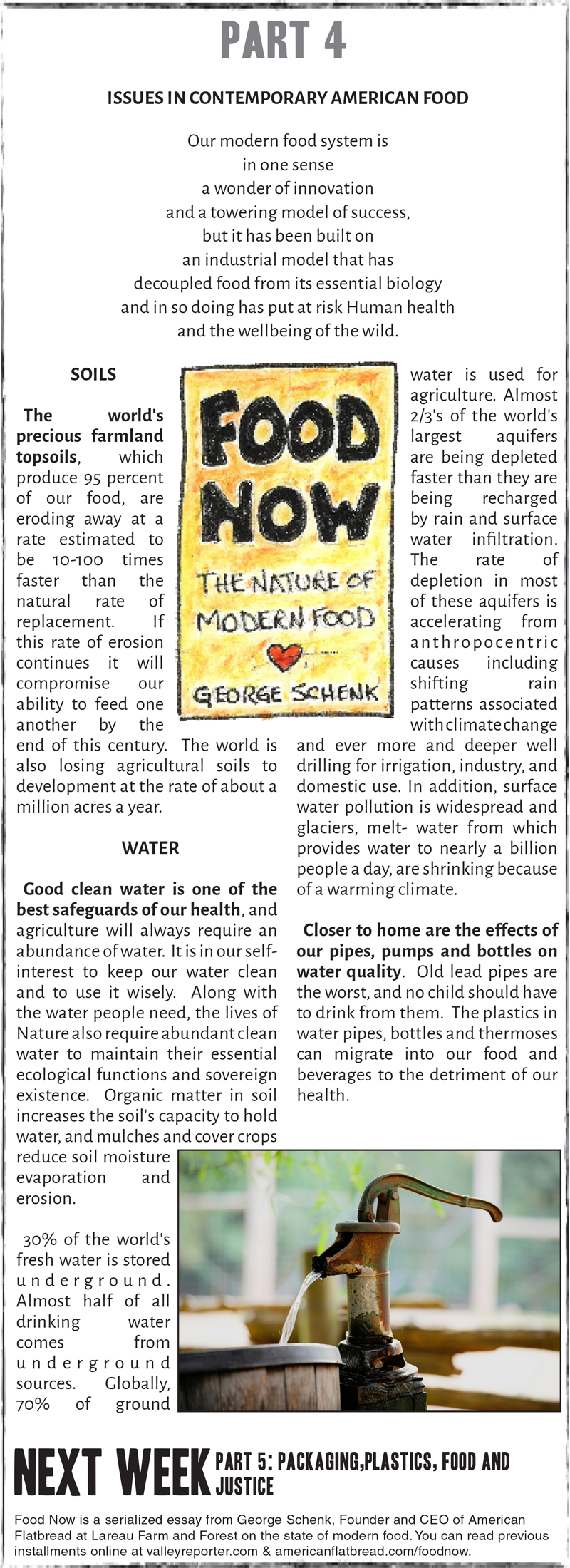
ISSUES IN CONTEMPORARY AMERICAN FOOD
Our modern food system is
in one sense
a wonder of innovation
and a towering model of success,
but it has been built on
an industrial model that has
decoupled food from its essential biology
and in so doing has put at risk Human health
and the wellbeing of the wild.
SOILS
The world’s precious farmland topsoils, which produce 95 percent of our food, are eroding away at a rate estimated to be 10-100 times faster than the natural rate of replacement. If this rate of erosion continues it will compromise our ability to feed one another by the end of this century. The world is also losing agricultural soils to development at the rate of about a million acres a year.
WATER
Good clean water is one of the best safeguards of our health, and agriculture will always require an abundance of water. It is in our self-interest to keep our water clean and to use it wisely. Along with the water people need, the lives of Nature also require abundant clean water to maintain their essential ecological functions and sovereign existence. Organic matter in soil increases the soil’s capacity to hold water, and mulches and cover crops reduce soil moisture evaporation and erosion.
30% of the world’s fresh water is stored underground. Almost half of all drinking water comes from underground sources. Globally, 70% of ground water is used for agriculture. Almost ⅔’s of the world’s largest aquifers are being depleted faster than they are being recharged by rain and surface water infiltration. The rate of depletion in most of these aquifers is accelerating from anthropocentric causes including shifting rain patterns associated with climate change and ever more and deeper well drilling for irrigation, industry, and domestic use. In addition, surface water pollution is widespread and glaciers, melt- water from which provides water to nearly a billion people a day, are shrinking because of a warming climate.
Closer to home are the effects of our pipes, pumps and bottles on water quality. Old lead pipes are the worst, and no child should have to drink from them. The plastics in water pipes, bottles and thermoses can migrate into our food and beverages to the detriment of our health.
NEXT WEEK Part 5: Packaging, Plastics, Food and Justice
Food Now is a serialized essay from George Schenk, Founder and CEO of American Flatbread at Lareau Farm and Forest on the state of modern food.
PART 5
PACKAGING
It once was food was held in gourds, animal skins, stone and clay pots, paper bags, glass bottles, and wooden boxes and barrels. Today it is a rare piece of food that has not been touched by plastics. Cheap and effective, plastic films and containers have become an indispensable tool for protecting food from contaminates while extending its shelf life. As a waste product, persistent plastics fill our landfills, litter our roadways and shorelines, accumulate in the oceans where they are easily mistaken for food and ingested by fish, turtles, and birds, and micro and nano plastic particles contaminate the air we breathe, the soil we till, the water we drink, and the food we eat.
We live in a world immersed in the novel chemistry of plastics. The cumulative effect of all this exposure is not well understood but preliminary evidence suggests that plastics such as phthalates used to make plastics more flexible and bisphenols (BPA) act as endocrine disrupters which can contribute to a host of Human illnesses including diabetes, obesity, cardiovascular disease, certain cancers, birth defects, neurodevelopmental disorders, and infertility.
And modern food packaging takes a lot of paper products that are resource and energy intensive. The estimated global production of cardboard in 2022 was 72 million tons, up 25% since 2015. In the U.S. 75% of cardboard and paperboard are recycled. Recycling helps; it saves energy, water, and emits less sulfur dioxide compared to using virgin wood pulp.
TRANSPARENCY
Much of modern food has been transformed by global businesses which too often intentionally obscure the real nature of their agricultural practices and ingredients.
An essential pillar of free market economies is informed consent. It is by open information that buyers can evaluate the benefit of goods and services which allows markets to self-correct and over time to evolve, providing ever better goods and services. It is in our self-interest to know what is in our food. In my view, it would be helpful if all food was required to list in a truly readable way, treatments of pesticides, growth hormones, antibiotics, and a NOVA number (1-4) indicating the level of UPF ingredients, and like cigarettes and alcohol, come with a warning that pesticides are harmful to the environment and may put at risk human health, and that NOVA -4 ingredients are known to be addictive and contribute to human diseases.
FOOD and JUSTICE
The Ancient Greek philosopher Thales wrote that there is nothing greater than necessity. The necessity of food moves people and has often shaped the fate of nations.
There is currently enough food for everyone but sufficient food is not available to everyone. More pronounced flooding, droughts, and temperature extremes - each a fingerprint of climate change, the cost of fertilizer, and soil erosion and desertification have made farming less productive on marginal lands, but globally the largest contributor to food insecurity is social unrest and violence. Worldwide it is estimated that one in ten people are food insecure. In the U.S. the cause of hunger is poverty. It is estimated that at least one in five households experience food insecurity.
Further, in the Global South up to twenty million children are caught up in debt bondage and “forced labor coerced by violence” (slavery) to harvest tropical commodities such as coffee beans, cocoa beans, and bananas.
NEXT WEEK Part 6: Pesticides, Ultra-Processing and Insects
Food Now is a serialized essay from George Schenk, Founder and CEO of American Flatbread at Lareau Farm and Forest on the state of modern food.
PART 6
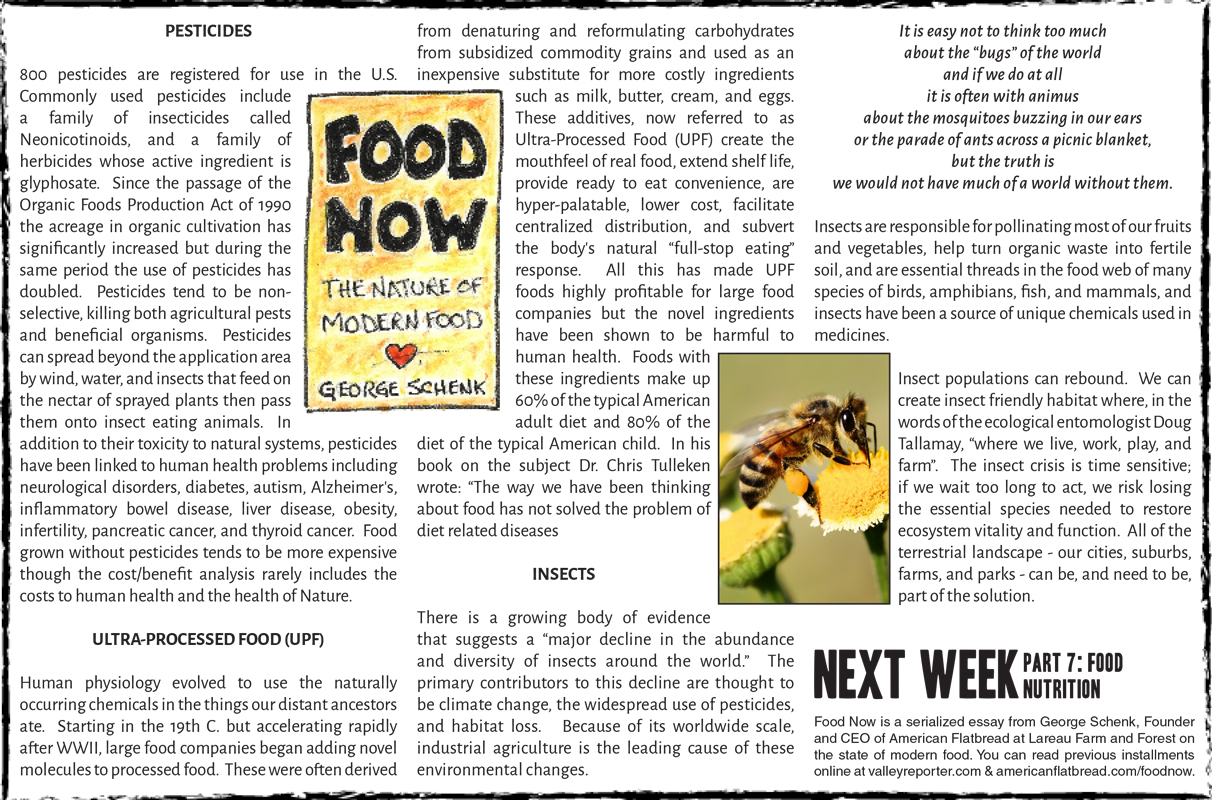
PESTICIDES
800 pesticides are registered for use in the U.S. Commonly used pesticides include a family of insecticides called Neonicotinoids, and a family of herbicides whose active ingredient is glyphosate. Since the passage of the Organic Foods Production Act of 1990 the acreage in organic cultivation has significantly increased but during the same period the use of pesticides has doubled. Pesticides tend to be non-selective, killing both agricultural pests and beneficial organisms. Pesticides can spread beyond the application area by wind, water, and insects that feed on the nectar of sprayed plants then pass them onto insect eating animals. In addition to their toxicity to natural systems, pesticides have been linked to human health problems including neurological disorders, diabetes, autism, Alzheimer’s, inflammatory bowel disease, liver disease, obesity, infertility, pancreatic cancer, and thyroid cancer. Food grown without pesticides tends to be more expensive though the cost/benefit analysis rarely includes the costs to human health and the health of Nature.
ULTRA-PROCESSED FOOD (UPF)
Human physiology evolved to use the naturally occurring chemicals in the things our distant ancestors ate. Starting in the 19th C. but accelerating rapidly after WWII, large food companies began adding novel molecules to processed food. These were often derived from denaturing and reformulating carbohydrates from subsidized commodity grains and used as an inexpensive substitute for more costly ingredients such as milk, butter, cream, and eggs. These additives, now referred to as Ultra-Processed Food (UPF) create the mouthfeel of real food, extend shelf life, provide ready to eat convenience, are hyper-palatable, lower cost, facilitate centralized distribution, and subvert the body’s natural “full-stop eating” response. All this has made UPF foods highly profitable for large food companies but the novel ingredients have been shown to be harmful to human health. Foods with these ingredients make up 60% of the typical American adult diet and 80% of the diet of the typical American child. In his book on the subject Dr. Chris Tulleken wrote: “The way we have been thinking about food has not solved the problem of diet related diseases
INSECTS
There is a growing body of evidence that suggests a “major decline in the abundance and diversity of insects around the world.” The primary contributors to this decline are thought to be climate change, the widespread use of pesticides, and habitat loss. Because of its worldwide scale, industrial agriculture is the leading cause of these environmental changes.
It is easy not to think too much
about the “bugs” of the world
and if we do at all
it is often with animus
about the mosquitoes buzzing in our ears
or the parade of ants across a picnic blanket,
but the truth is
we would not have much of a world without them.
Insects are responsible for pollinating most of our fruits and vegetables, help turn organic waste into fertile soil, and are essential threads in the food web of many species of birds, amphibians, fish, and mammals, and insects have been a source of unique chemicals used in medicines.
Insect populations can rebound. We can create insect friendly habitat where, in the words of the ecological entomologist Doug Tallamay, “where we live, work, play, and farm”. The insect crisis is time sensitive; if we wait too long to act, we risk losing the essential species needed to restore ecosystem vitality and function. All of the terrestrial landscape - our cities, suburbs, farms, and parks - can be, and need to be, part of the solution.
NEXT WEEK Part 7: Food Nutrition
Food Now is a serialized essay from George Schenk, Founder and CEO of American Flatbread at Lareau Farm and Forest on the state of modern food.
You might also like




